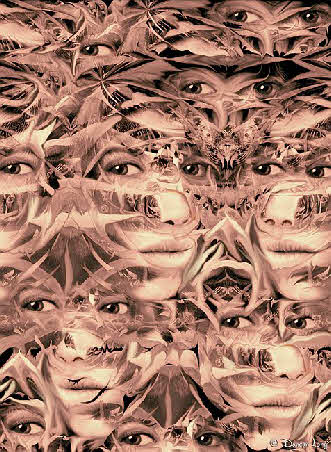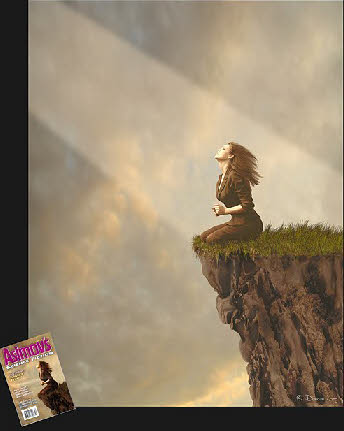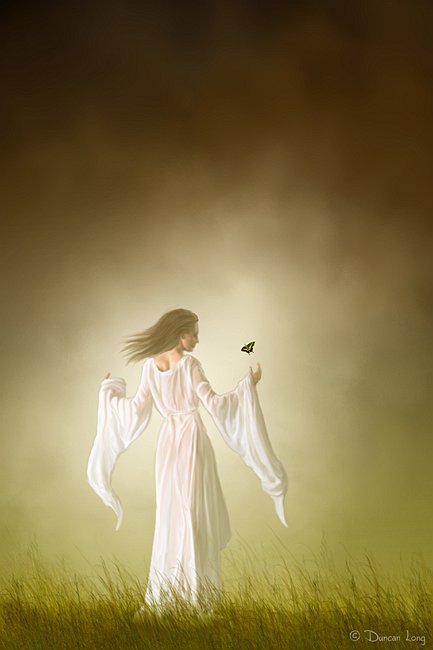Outsider Visionary Artist Duncan Long
As Interviewed by Phil Hunter
Phil Hunter: I’ve seen you described as an “Outsider Visionary Artist” – does that aptly describe your work?
Duncan Long: I hate to be pigeonholed. But I suppose that at least some of my work would fall into that category.
Hunter: Let’s break that down a bit and see how well it fits. Perhaps the biggest surprise would be the “outsider artist” part since many people who see your illustrations think they're done by an artist who's had a lot of schooling. But in fact you’re a genuine outsider artist, a person with no formal training in that field and therefore “outside” the established art community, isn’t that correct?
Long: That’s correct. I have a Master’s degree from Kansas State University – but in music composition. The only formal art training I have received came in grade school. However, my dad was interested in art and encouraged me to read several how–to–draw books and the like. And both my parents were always encouraging me to draw, which I did about every chance I got for as long as I can remember.
Hunter: So you had no art classes in high school or college?
Long: My high school was small, offering only the basics. We had a total of 18 students in my graduating class.
Hunter: And that was a rural community wasn't it – something else that often seems to encourage outsider artists to blossom.
Long: Yes, I’m not sure why outsider artists tend to come from rural areas – though there may be a simple explanation. If they live where they can’'t find formal training they train themselves. Say, I should make one correction. I did have a single art course in college – how to teach art to grade school students.
Hunter: That's an odd choice. How did that come about?
Long: By accident. I needed it to teach music to grade school students. Or so I thought. It turned out my adviser had made a mistake so I didn’t need the course since I already had the needed “teaching grade schools students” class elsewhere. So my one college art class was an almost total waste of time all the way around. I spent time in that class being told to be sure that pupils pushed heavily with their crayons to get full color, used scissors carefully, etc., etc. I’m sure it would have been an ideal class for grade school teachers, but it was a drag for me at that time.
Hunter: So there really can be no argument that you're an outsider artist; with no formal training, you are in the outsider artist camp simply by definition. Now what about the “Outsider Visionary Artist?” Does that tag fit as well?
Long: I’m less comfortable with the “visionary artist” part, though it is accurate with some of my artwork.
Hunter: Visionary artists tend to portray apocalyptic events in their artwork, often finding their inspiration from the prophetic books of the Bible.
Long: I do create such work from time to time as well as end-
Hunter: And, if we hold that you’re also an outsider artist, then the “Outsider Visionary Artist,” then that moniker probably fits, at least part of the time.
Long: I’ll go along with “some of the time.”
Hunter: Much of your science fiction, fantasy, and horror pictures also seems to fit into that category.
Long: Yes, that’s probably true. So perhaps “Outsider Visionary Artist” fits better than I thought. However, I would argue that our whole culture has the feel of living on the edge of disaster, with terrorism, nuclear weapons, various diseases, possible economic collapse – the newspaper could turn almost any creative thinker into a visionary artist.
Hunter: Many of your futuristic illustrations have a somewhat dark side, as does your religious artwork, the latter being somewhat unique among religious artists.
Long: (Laugh). Yes, that's true. People who know me are sometimes surprised at the sinister tone of some of my graphic artwork. Likewise, some of those familiar with my illustrations assume I must be some murky guy living in a dark, dank castle with a battle ax in hand.
Hunter: That disturbing tone in artwork also seems to be a hallmark of the visionary artist, doesn’t it?
Long: I suppose so. But one might say that about much of the art of the 20th century as well as (at least) the beginning of the 21st. With the horrific events in Nazi Germany as well as the slaughters of millions more overseen by communist governments in Russia, China, Cambodia, and elsewhere, it’s hard for any medium that holds a mirror to society to avoid a pessimistic view of things. I think the important difference with the visionary artist is that there’s a feeling of hope in the future (or at least the thought that evil will be punished), due to religious beliefs.
Hunter: I know churches sometimes use your artwork in services. How did that come about? And does the dark tone of your artwork interfere with such use?
Long: I started getting requests from Christian groups to use my artwork after I started posting pieces on the web. Some of the visionary art seemed to dovetail with their needs, and so as people started writing to ask, I started creating PowerPoint versions for them to use. Some people are bothered by the dark feeling of some of the artwork – one guy even wrote to inform me that he was certain I was the ''Spawn of Satan.''
Hunter: Really? Someone used those exact words?
Long: Verbatim. It was so weird that it was more funny than troubling. But I’ve had people note that today the message that there’s a Hell or punishment for sins has about vanished from many pulpits, and along with it, artwork about these subjects. So from that standpoint, I guess my visionary art fills a sort of niche market for churches needing to preach Hellfire and damnation sermons, or show that there is a fallen nature to humanity. As one of those who uses my artwork noted, “If there's no Hell, most people fail to see any real reason that they should give up sin.”
Hunter: Most outsider art is, to be kind, crude though often powerful and certainly unique. Your work is much more polished. Why is that?
Long: Well, I suppose that it comes from years of drawing. A lot of outsider artists
don’t start producing work until midlife and therefore have the vision but not the
skills needed for a polished work. Their work is powerful, but not well crafted.
Interestingly, I seem to have hit my stride in mid-
Hunter: Most of your artwork appears to have perfect perspective, vanishing points, and so forth.
Long: Not always because of my talents, though. The saving grace is that I work digitally. Most of the current outsider artists who are well known work in oils or similar media. Coming at the tale end of this generation of outsider artists, and being interested in computers from about day one (in fact the first real electronic computer was created the year of my birth), I quickly adapted to computer graphics. And today many of these programs automatically plot out the proper perspective, vanishing points, and “bluing” of objects in the distance. That said, they also become teachers of sorts; I see how they achieve the effects and then can apply them to my artwork so my native abilities improve as well.
Hunter: So the computer does the heavy lifting of traditional art, freeing you to create without worrying so much about the rules.
Long: Exactly right.
Hunter: Outsider artists often produce huge amounts of artwork -
Long: Yes. Well, I did. I probably had several thousand illustrations online for people to see. Recently, I’ve culled some of the “strays” that were a bit too crude for my taste. There are still several hundred available for viewing and I’ll add more as long as I can.
Hunter: So you have additional artwork not seen on your site?
Long: Tons. I have notebooks of stuff no one has every seen besides me. And lots of graphic artwork on my computer as well.
Hunter: That seems to be another trait unique to outsider visionary artists: As often as not, they produce art more for themselves than for an audience.
Long: I suppose that’s true with me, too. While I do produce a lot of book and magazine covers these days, most of my illustrations start mostly for me, produced almost compulsively. If it weren’t for the Internet, no one would see a lot of what I’m doing. Fortunately, it only takes me about an hour to create the HTML coding for a “gallery” of graphic artwork that can be uploaded to the net.
Hunter: You don’t have any physical work in any galleries or such?
Long: Nothing to date. Everyone’s after me to produce signed glicees of my work. But I’m not ready yet.
Hunter: Your work generally doesn’t look all that digital. In fact, some is easily mistaken for oils, one of the favorite mediums for outsider visionary artists.
Long: I strive for a “painterly look.” But it’s all digital. I boxed up my pens and paintbrushes about ten years ago and have never looked back. I should note that there’s still a lot of tinkering with the pictures, though. Even when a picture is completely rendered in a computer program, I never leave it at that. Instead I move it into a paint program and then modify it extensively, often to the point that it is barely recognizable from the original render.
Hunter: I understand you use quite a diverse collection of programs and techniques.
Long: Yes, I’m not loyal to any given program. I use whatever will do the job best and most quickly. I look at software like the tools on a workbench. If I need to cut a piece of wood, I use a saw, not scissors. But trying to use the saw to cut paper is futile. It can be done, but not well. I know digital artists that try to do everything in one program, but to me that’s like trying to use the saw to cut paper. My loyalty is to the artwork, not the tool.
Hunter: Regardless of how your work is produced, your outsider visionary artwork is often breathtaking. Thanks for taking the time for this interview.
Long: It’s been my pleasure.
Copyright © 2005, 2008, 2009 by Duncan Long. All rights reserved. Reproduction in any manner of text, book cover illustrations, graphic artwork, book cover designs, or other graphic designs on this page or the pages it links to is strictly prohibited without prior written approval from graphic designer Duncan Long. All CD cover art and book cover illustrations and book cover graphic artwork were created by freelance artist Duncan Long.
Soli Deo Gloria
Mary’s Vision by Duncan Long, 2008 -
Agendas by Duncan Long, 2001.
Wolf Night by Duncan Long, 2009.


Where the Sky Kisses the Sea by Duncan Long, 2007.


The Magical Contact by Duncan Long, 2009.
